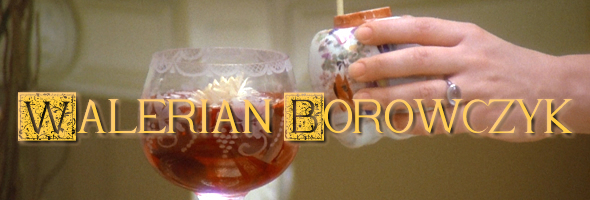
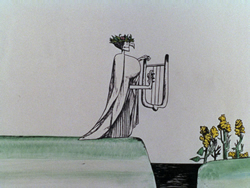
The avalanche of daring, taboo-smashing cinema unleashed from Europe from the 1960s through the 1980s is filled with notable directors, many of whom succeed in blurring the lines between high art and low trash. Everyone from Fellini to Franco indulged in the increasing freedom of the screen, and few confounded critics and audiences more than Polish-born filmmaker Walerian Borowczyk. He first made his name with a string of acclaimed animated short films but took several unexpected turns in his feature-length career, dabbling in everything from ornate 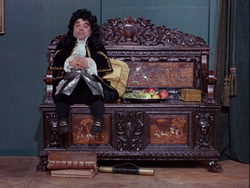 period dramas to shocking, sexually explicit horror films. His esteemed reputation took a nosedive among critics when he unleashed his two most scandalous films in the mid-1970s, Immoral Tales and The Beast, but the ensuing years have led to many reappraisals finally reconciling his artistry and penchant for shock value. Various video labels have offered different releases over the years, but the most elaborate and satisfying by far is the astonishing collection assembled by Arrow Films in the U.K., available either as a limited edition set called Camera Obscura (which sold out very quickly) or as five individual editions with the same video contents, each on Blu-ray or DVD.
period dramas to shocking, sexually explicit horror films. His esteemed reputation took a nosedive among critics when he unleashed his two most scandalous films in the mid-1970s, Immoral Tales and The Beast, but the ensuing years have led to many reappraisals finally reconciling his artistry and penchant for shock value. Various video labels have offered different releases over the years, but the most elaborate and satisfying by far is the astonishing collection assembled by Arrow Films in the U.K., available either as a limited edition set called Camera Obscura (which sold out very quickly) or as five individual editions with the same video contents, each on Blu-ray or DVD.
The first disc is essentially a primer on Borowczyk's groundbreaking animation work with one major centerpiece, the 77-minute feature Theatre of Mr. and Mrs. Kabal from 1967. A film "drawn for adults" with classical music by "the Santa Claus Orchestra," it's a mad, hand-drawn fantasia about a couple -- the older, busty wife and her very diminutive husband -- who dance to jaunty French music, spy on neighbors, cavort with animals (including omnipresent butterflies), blow holes in each other, go to the movies, undergo surgery, and occasionally interact with brief snippets of stock footage. It's all completely surreal and often hilarious, perhaps not the best starting point for newcomers but a terrifically valuable gem for cineastes, fans of the director, and animation buffs. The 4:3 HD transfer looks excellent, flawless in fact, with the lovingly handcrafted visuals never looking better.
Also included are twelve additional shorts from 1959 to 1984, starting with "The Astronauts," made with Chris Marker. It's a quirky combination of tinted still photographs, cut outs, and traditional animation to show a mustachioed man using any tools at his disposal to build a spacecraft at home. Accompanied by Beethoven and eerie sound effects, he succeeds and experiences a space voyage unlike you've ever seen. Next is "The Concert" (1962), a sort of 7-minute dry run for Kabal with the same two characters morphing into mad geometric, mechanical pieces during a music performance. "Grandma's Encyclopedia' (1963), running just under 7 minutes, animates goofy explosions and jaunty 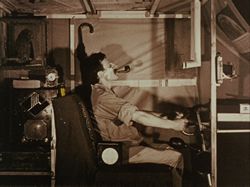 music to depict a race via automobile and balloon depicted in the style of 19th century print advertisements. The 9-minute "Renaissance" (1963) is very difficult to describe but basically involves lots of battered, discarded trash coalescing into an entire room with a doll, an owl, a painting, grapes, and so on; it's technically fascinating and the first real indication of the antiquity fascination that would become a defining trait in Borowczyk's later cinema. "Angels' Games" (1964) starts off with an abstract animation of a running train before morphing into 12 minutes of increasingly baroque, colorful visuals involving various winged creatures, viscera and wooden surfaces. "Joachim's Dictionary" (1965) is a slightly more traditional 9-minute piece of silliness with various words flashing on the screen between ink drawings of a man eating, spitting, changing outfits, and other easily definable (and often absurd) activities. "Rosalie" (1966) switches over to live action for a 15-minute study of a woman impregnated out of wedlock who tearfully deals with the aftermath of a life-changing decision. It's an eerie, poetic black-and-white miniature that leads nicely into some of the later works to come. Then "Gavotte" (1967) offers a crazy midget's eye view of life in a French imperial court, complete with humorous harpsichord music and some pretty hilarious gags that would never fly today. The same year's "Diptych" runs 8 minutes and features two "panels" about Leon Boyer, a 100-year-old bachelor tilling his garden and going out for a country drive, and a colorful study of flowers (and kittens!) set to Bizet music. What they have to do with each other is anyone's guess, but it looks gorgeous. "The Phonograph" (1969) runs a bit over 5 minutes and features stop-motion animation as the device of the title is shown operating in extreme detail, interspersed with shots of a shattered photograph and a rose. Then we jump ahead to 1978 for "The Greatest Love of All Time," a 9-minute fusion of painting footage, candid city shots, and Wagner music, with a slightly monstrous, sexy twist near the end. Finally, "Scherzo Infernal" (1984) uses narration, collage, and impressionistic animation to tell a story involving demons, fallen angels, and dark comedy within the flames of hell. Want even more? Among the special features you get a new one-minute introduction by Terry Gilliam, who reflects on the impression these shorts made on him decades ago, and the 28-minute featurette "Film Is Not a Sausage," with vintage interview footage of the late director, some of his regular collaborators (who will be discussed in more detail below), and various text excerpts and film clips covering this wildly productive aspect of his career. The 4-minute "Blow Ups" takes a closer look at Borowczyk's paper work in Poland and France, including some striking paintings and drawings with imagery later carried over to his film work (whose promotional artwork he sometimes designed as well). Finally you get a trio of lengthy commercials made between 1963-4: "Holy Smoke," "The Museum," and a pretty wild version of "Tom Thumb." Incidentally, this is the one of the two region-free titles out of the five. That leads us into...
music to depict a race via automobile and balloon depicted in the style of 19th century print advertisements. The 9-minute "Renaissance" (1963) is very difficult to describe but basically involves lots of battered, discarded trash coalescing into an entire room with a doll, an owl, a painting, grapes, and so on; it's technically fascinating and the first real indication of the antiquity fascination that would become a defining trait in Borowczyk's later cinema. "Angels' Games" (1964) starts off with an abstract animation of a running train before morphing into 12 minutes of increasingly baroque, colorful visuals involving various winged creatures, viscera and wooden surfaces. "Joachim's Dictionary" (1965) is a slightly more traditional 9-minute piece of silliness with various words flashing on the screen between ink drawings of a man eating, spitting, changing outfits, and other easily definable (and often absurd) activities. "Rosalie" (1966) switches over to live action for a 15-minute study of a woman impregnated out of wedlock who tearfully deals with the aftermath of a life-changing decision. It's an eerie, poetic black-and-white miniature that leads nicely into some of the later works to come. Then "Gavotte" (1967) offers a crazy midget's eye view of life in a French imperial court, complete with humorous harpsichord music and some pretty hilarious gags that would never fly today. The same year's "Diptych" runs 8 minutes and features two "panels" about Leon Boyer, a 100-year-old bachelor tilling his garden and going out for a country drive, and a colorful study of flowers (and kittens!) set to Bizet music. What they have to do with each other is anyone's guess, but it looks gorgeous. "The Phonograph" (1969) runs a bit over 5 minutes and features stop-motion animation as the device of the title is shown operating in extreme detail, interspersed with shots of a shattered photograph and a rose. Then we jump ahead to 1978 for "The Greatest Love of All Time," a 9-minute fusion of painting footage, candid city shots, and Wagner music, with a slightly monstrous, sexy twist near the end. Finally, "Scherzo Infernal" (1984) uses narration, collage, and impressionistic animation to tell a story involving demons, fallen angels, and dark comedy within the flames of hell. Want even more? Among the special features you get a new one-minute introduction by Terry Gilliam, who reflects on the impression these shorts made on him decades ago, and the 28-minute featurette "Film Is Not a Sausage," with vintage interview footage of the late director, some of his regular collaborators (who will be discussed in more detail below), and various text excerpts and film clips covering this wildly productive aspect of his career. The 4-minute "Blow Ups" takes a closer look at Borowczyk's paper work in Poland and France, including some striking paintings and drawings with imagery later carried over to his film work (whose promotional artwork he sometimes designed as well). Finally you get a trio of lengthy commercials made between 1963-4: "Holy Smoke," "The Museum," and a pretty wild version of "Tom Thumb." Incidentally, this is the one of the two region-free titles out of the five. That leads us into...
GOTO, THE ISLAND OF LOVE
B&W/Color, 1968, 95m.
Directed by Walerian Borowczyk
Starring Pierre Brasseur, Ligia Branice, Jean-Pierre Andréani, Ginette Leclerc
Arrow (Blu-ray & DVD) (UK RB/R2 HD/PAL),
Olive Films (Blu-ray) (US RA HD), Cult Epics (US R1 NTSC) / WS (1.66:1) (16:9)
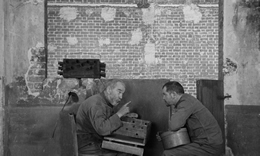 After earning a name for himself with Kabal, Borowczyk embarked on his first live-action film with the peculiar and fascinating Goto, Island of Love in 1968. Though anyone acquainted with his later work might expect a combination of elegance and naughtiness, the film is quite a bit stranger than that, mixing political commentary with whimsical fantasy and poetic visuals into a truly unique and surprising experience.
After earning a name for himself with Kabal, Borowczyk embarked on his first live-action film with the peculiar and fascinating Goto, Island of Love in 1968. Though anyone acquainted with his later work might expect a combination of elegance and naughtiness, the film is quite a bit stranger than that, mixing political commentary with whimsical fantasy and poetic visuals into a truly unique and surprising experience.
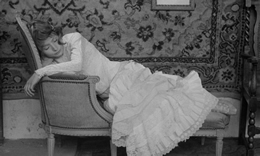
On an isolated island unclaimed by any larger principalities, Goto (Brasseur) rules with a "generous" but firm patriarchal fist, with his wife, Glossia (Brancie, familiar from Chris Marker’s La Jetée and the director's spouse), steady at his side. Essentially a dictatorship, the island is filled with a colorful assortment of characters who all fulfill their roles according to their social caste; however, enterprising Gono (Andréani) has other ideas, particularly when a reprieve from execution brings him into close contact with the rulers. At first assigned with odd but rewarding tasks like walking the royal dogs and catching insects, he begins a flirtation with the queen and orchestrates a political shift in power that may change the power structure of the island forever.
Filled with odd little grace notes and narrative tangents, Goto is fairly low on overt eroticism (mainly a few brief bare backsides and some corset-handling) but high on visual eccentricity that's unmistakably Borowczyk. The black and white cinematography (with a quick splash of color) reveals one formal composition after another designed to evoke the mood of a lost painting, with characters precisely placed in unusual compositions like a theater project gone slightly askew. One particularly striking scene features the releasing of the monarch's German Shepherds, a sequence possibly designed to pay homage to Brasseur's final scene in Eyes without a 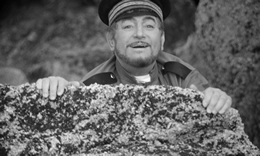 Face. The director's trademark oddball sense of humor is here as well, particularly in Gono's outrageous Machiavellian tactics which take several unusual twists and turns.
Face. The director's trademark oddball sense of humor is here as well, particularly in Gono's outrageous Machiavellian tactics which take several unusual twists and turns.
Goto first appeared on DVD in the U.S. in 2006 as one of four of his titles from Cult Epics, sporting a nice anamorphic transfer from a rare film element. The print features some fluttering black levels here and there, but the quality is sharp enough with good contrast. As with many titles supplied from licensor Argos at the time, the English subtitles were burned-in but at least remain clear and readable throughout. Extras included "The Astronauts,", the theatrical trailer, and thorough liner notes by Rayo Casablanca which laid out the film's placement in the director's filmography while sketching out some of its major themes.
However, the Arrow release blows that one out of the water with an often breathtaking 2K restoration (whose details are spelled out before the film). It's a richly detailed, impressive presentation from start to finish and far better than anyone had a right to expect. The LPCM French mono audio features typically solid, optional English subtitles. The extras start with a new video intro by artist Craigie Horsfield, who chats for 8 minutes about the film's personal significance and the blurry line between animation and live action. "The Concentration Universe" offers a new 21-minute look at the making of the film with actor Jean-Pierre Andréani, regular camera operator and cinematographer Noel Very, focus puller Jean-Pierre Platel, discussing the filmmaker's preoccupations, attention to detail, Chaplin influences, and solutions to production problems with the sets, not to mention the principles of "God lighting." Along with the original trailer, "The Profligate Door" takes a 13-minute look at Borowczyk's "sound sculptures," with his elaborate sound effects achieved through various old-fashioned wooden gears and other ephemera to create the right ambience. Curator Maurice Corbet walks through some of the devices used on his films, which sheds quite a light on an aspect often overlooked but definitely an integral part of his cinematic flavor.
BLANCHE
Color, 1972, 93m.
Starring Michel Simon, Jacques Perrin, Ligia Branice, Georges Wilson, Denise Péronne, Lawrence Trimble
Arrow (Blu-ray & DVD) (UK R0 HD/PAL), Olive Films (Blu-ray) (US RA HD) / WS (1.66:1) (16:9)
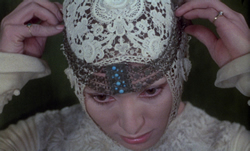 Borowczyk’s second feature film, Blanche, earned some of the best reviews of his career and turned out to be a major success in the United Kingdom (despite lukewarm audience response in France). Apart from a bit of nudity in the opening moments it completely avoids the sensuality that would characterize his later work; instead we have a medieval melodrama mounted in the style of classical etchings and paintings with the camera taking a dispassionate, almost disturbing view of the increasingly violent events.
Borowczyk’s second feature film, Blanche, earned some of the best reviews of his career and turned out to be a major success in the United Kingdom (despite lukewarm audience response in France). Apart from a bit of nudity in the opening moments it completely avoids the sensuality that would characterize his later work; instead we have a medieval melodrama mounted in the style of classical etchings and paintings with the camera taking a dispassionate, almost disturbing view of the increasingly violent events.
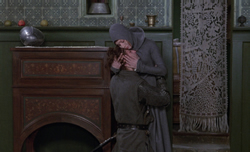
Branice returns form Goto as the title character, a young woman married to the much older, unnamed master (famous French actor Simon from Boudou Saved from Drowning) of the estate. Complications ensue when they serve as hosts for the King (Wilson) and his page, Bartolomeo (Perrin, star of two Jacques Demy films), both of whom fall for her. Also courting her is her own stepson, Nicolas (Trimble), which leads to a series of machination by the King resulting in a rapidly-increasing tally of dead bodies.
Drawing equal parts inspiration from Polish legends and a poem by Lord Byron, Blanche is a gorgeously mounted film with striking costumes and production design rubbing shoulders with an effective score comprised of vintage instruments and vocal performances. The film really came at the beginning of the vogue for medieval films in the ‘70s (with its closest successor probably being Eric Rohmer’s Perceval), with its only really close predecessor probably being Giuseppe Patroni Griffi’s beautiful and savage ‘Tis Pity She’s a Whore. The horrific nature of the story 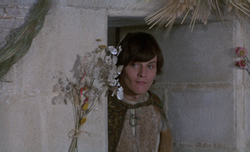 may also come as a bit of a surprise given that the set up feels more akin to bedroom farce, but that really just amplifies the impact of the conclusion even more. (The handheld final moments are especially wrenching.)
may also come as a bit of a surprise given that the set up feels more akin to bedroom farce, but that really just amplifies the impact of the conclusion even more. (The handheld final moments are especially wrenching.)
For some reason, Blanche has been extremely difficult to see for most English-speaking viewers outside of a British VHS release. The Arrow version is a major event for Borowczyk fans as well as a crucial revival for a significant world cinema title, and it looks terrific. The original grain structure appears to have been left as is, and the detail in the carefully composed imagery (most of it medium shots) is impressively tactile throughout. The French LPCM audio also sounds quite fine, with optional English subtitles.
Filmmaker Leslie Megahey contributes a four-minute video intro (with a BFI logo) in which he discusses the film's unorthodox approach to doing a period film, while the 28-minute "Ballad of Imprisonment" covers the making of the film with interviews with the great director Patrice Leconte (who served as second assistant director here), the film's first assistant director, Andre Heinrich, co-producer Dominique Duverge, and camera assistant Guy Durban, complete with discussions of Borowczyk's animated work before it and mentions of alternate casting suggestions including Catherine Deneuve. The shoot itself was apparently a contentious one with both Perrin and Simon clashing with the director. The 63-minute "Obscure Pleasures: A Portrait of Walerian Borowczyk" features a French-language interview with the filmmaker studded with a large array of clips, covering his views on film, art in general, alchemy, sex, the absolute freedom of animation, and plenty more. The 1972 short "Gunpoint (Au bout des fusils)" is an unsettling portrait of a pheasant farm where the inhabitants are bred from birth eventually released en masse into the countryside for hunters. Borowczyk served in multiple capacities here for director Peter Graham (who also contributes a five-minute interview about the making of the short.
IMMORAL TALES
Color, 1974, 103 mins.
Directed by Walerian Borowczyk
Starring Paloma Picasso, Lise Danvers, Fabrice Luchini, Charlotte Alexandra
Arrow (Blu-ray & DVD) (UK RB/R2 HD/PAL), Anchor Bay (US R1 NTSC) / WS (1.66:1) (16:9)
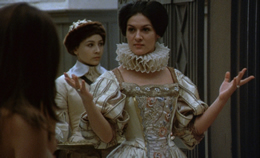 Of course, it was just a matter of time before Borowczyk dabbled in the anthology film, a craze Europe had been nurturing for quite a few years. This long lost art of the '60s and '70s allowed notable directors of all stripes and nationalities to experiment with any number of running times and story genres, with a wide range of actors at their disposal. Borowczyk found his greatest international success with this artsy, provocative variation on this formula, for which he somehow managed to rope in Pablo Picasso's fashion-savvy daughter, Paloma, to portray the real life, bloodthirsty Erzebeth Bathory. Needless to say, the results left quite an impression on unprepared moviegoers.
Of course, it was just a matter of time before Borowczyk dabbled in the anthology film, a craze Europe had been nurturing for quite a few years. This long lost art of the '60s and '70s allowed notable directors of all stripes and nationalities to experiment with any number of running times and story genres, with a wide range of actors at their disposal. Borowczyk found his greatest international success with this artsy, provocative variation on this formula, for which he somehow managed to rope in Pablo Picasso's fashion-savvy daughter, Paloma, to portray the real life, bloodthirsty Erzebeth Bathory. Needless to say, the results left quite an impression on unprepared moviegoers.
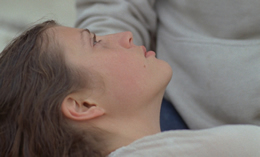
The lustful nature of mankind reveals itself in a quartet of tales ranging from medieval Italy to the present day. In the first, a rakish young man (In the House's Luchini) escorts his naive young sixteen-year-old cousin to the seaside, where he talks her into performing sexual favors as the tide rolls in. Then in "Therese the Philosopher," a young Victorian-era girl undergoes a rapturous sexual awakening with the aid of a few handy household props and vegetables. But that's nothing compared to "Countess Bathory," the infamous real-life noblewoman who rides into a local village, rounds up dozens of nubile young virgins, and escorts them back to her castle. There the girls strip, engage in harmless horseplay, and then... Well, if you don't know the legend, there's no point in spoiling the grisly surprise. Finally "Lucrezia Borgia" sexually cavorts with two men in her private chambers while a heretic burns outside; afterward the true identity of her partners is revealed.
Straddling uneasily somewhere between '70s art house pretension and softcore sleaze, Immoral Tales is beautiful to watch and remains one of the textbook examples of that shaky line between classical art and softcore erotica. The volume of nudity is incredibly high but strangely innocent, with Borowczyk's fascination with antiquity giving it all a strange, haunted air. It's still a mysterious and beguiling film for those receptive to its charms, and one can only wonder how mass audiences might have reacted had Borowczyk retained the original short film of "The Beast" which screened before the film was completed and was yanked to be turned into a separate feature. (More on that in a minute.) Some screenings were also accompanied by a vivid additional short/prologue, "A Private Collection" ("Une collection particulière"), which was removed for most general release versions outside France and Poland.
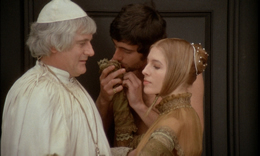 Though Immoral Tales played U.S. theaters with an X rating, a small amount of footage was lost from most prints compared to the stronger European cut. One bit in particular of a girl "stuffing" herself with pearls is a bit more graphic on the first DVD edition released by Anchor Bay in the U.S., with that European cut remaining the standard today. Very briefly released on U.S. VHS during the format's infancy, Immoral Tales was previously only available to collectors for years through underground sources and PAL conversions of the British
Though Immoral Tales played U.S. theaters with an X rating, a small amount of footage was lost from most prints compared to the stronger European cut. One bit in particular of a girl "stuffing" herself with pearls is a bit more graphic on the first DVD edition released by Anchor Bay in the U.S., with that European cut remaining the standard today. Very briefly released on U.S. VHS during the format's infancy, Immoral Tales was previously only available to collectors for years through underground sources and PAL conversions of the British 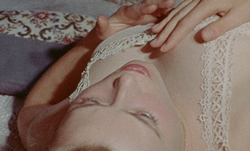 video release. The DVD was a much-needed relief at the time after such a long wait, and the presentation was fine if not pristine. The disc featured burned-in English subtitles (alas), with the original French and English-dubbed tracks included. The mono sound was fine, again limited by its age and the quiet nature of the film. The lurid U.S. trailer, complete with critical blurbs, was also included and might still make it one to hang on to.
video release. The DVD was a much-needed relief at the time after such a long wait, and the presentation was fine if not pristine. The disc featured burned-in English subtitles (alas), with the original French and English-dubbed tracks included. The mono sound was fine, again limited by its age and the quiet nature of the film. The lurid U.S. trailer, complete with critical blurbs, was also included and might still make it one to hang on to.
The Arrow revisit in 2014 is, not surprisingly, a huge upgrade in quality and should boost the film's critical reputation for its artistic merits. "The Tide" in particular is gorgeous with its pristinely composed landscape shots now evoking an intoxicating atmosphere of nature in the midst of a sexual fever. The second segment looks the roughest of the bunch simply by virtue of the way it was shot, with an intentionally grainy, degraded texture and low light levels. The French audio is the only choice (wisely) with optional English subtitles. A 5-minute video intro features text written by Daniel Bird and clips charting the film's evolution from a scandalous preview screening (of the two shorts not included in the final cut, oddly enough) through its successful European theatrical release. Also included is the "L'age d'or" cut of the film, clocking in at 125 minutes, which (via seamless branching) adds the original short film version of "The Beast" back in as the third tale; it's a fascinating alternate experience, to say the least. The 16-minute "Love Reveals Itself" is a new making-of featurette with Duverge and cameraman Noel Very sharing production stories about the difficulties of shooting on the beach, the issues of casting hordes of naked Swedish girls, and alternate casting suggestions including Isabelle Adjani. The 7-minute "Boro Brunch," shot in 2014, features Very reuniting with some of the other crew members from the '70s Borowczyk cycle and swapping anecdotes over wine and baguettes. Finally the disc rounds out with two cuts of "A Private Collection," the standard 12-minute one and a 14-minute "Oberhausen" alternate cut with additional shots of explicit vintage photographs and fleeting samples of ancient stag films, one implying the participation of a canine (which probably accounts for a note at the beginning about how this had to be modified to comply with UK laws). The original European trailer rounds out this particularly excellent presentation.
THE BEAST
Color, 1975, 98/94m.
Directed by Walerian Borowczyk
Starring Sirpa Lane, Lisbeth Hummel, Elisabeth Kaza, Pierre Benedetti, Guy Trejan
Arrow (Blu-ray & DVD) (UK RB/R2 HD/PAL), Cult Epics (US R1 NTSC), Nouveaux (UK R1 PAL) / WS (1.66:1) (16:9)
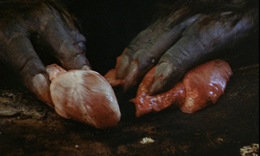 After earning a certain degree of mainstream credibility with Immoral Tales, Borowczyk immediately lost all of it shortly thereafter with La Bête (The Beast), a randy and explicit exploration of the underlying sexual motifs running through such fairy tales as "Beauty and the Beast" and "Little Red Riding Hood." The wordless 20-minute centerpiece of the film, in which noblewoman Sirpa Lane is pursued and ravished by a hairy and anatomically gifted beast, was that aforementioned component of Immoral Tales but seemed to
After earning a certain degree of mainstream credibility with Immoral Tales, Borowczyk immediately lost all of it shortly thereafter with La Bête (The Beast), a randy and explicit exploration of the underlying sexual motifs running through such fairy tales as "Beauty and the Beast" and "Little Red Riding Hood." The wordless 20-minute centerpiece of the film, in which noblewoman Sirpa Lane is pursued and ravished by a hairy and anatomically gifted beast, was that aforementioned component of Immoral Tales but seemed to 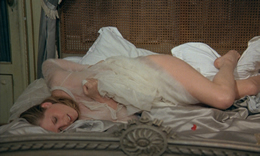 merit a separate film of its own. Borowczyk devised a crafty, Bunuelian narrative to surround this explosive little short, and soon he had quite a succès de scandale on his hands. Banned or heavily censored almost everywhere, The Beast was far more often spoken of than seen until it eventually resurfaced more or less intact on the English-speaking film circuit where its comic charms could be better appreciated.
merit a separate film of its own. Borowczyk devised a crafty, Bunuelian narrative to surround this explosive little short, and soon he had quite a succès de scandale on his hands. Banned or heavily censored almost everywhere, The Beast was far more often spoken of than seen until it eventually resurfaced more or less intact on the English-speaking film circuit where its comic charms could be better appreciated.
Wasting no time, the film lays out its primary theme immediately with the sight of horses breeding in the driveway of a country estate owned by the Esperance family, a dysfunctional household of lunatics intent on maintaining a sense of normalcy. Their financial stability depends on a marriage between the brutish son, Mathurin (Benedetti), and young English rose Lucy Broadhurst (Hummel), due to arrive with her aunt. Meanwhile the priest arrives for the baptism along with his uncomfortably close altar boys, the younger daughter cavorts with the virile black valet instead of tending to the children, and the entire house is rife with artifacts relating to the family's most infamous ancestor, Romilda (Lane), whose torn corset now hangs encased in glass in the drawing room. Lucy is welcoming into the house, where she immediately becomes fascinated with the story of Romilda after leafing through an illustrated diary. That night she feverishly relives Romilda's beastly ordeal in the nearby woods, and most surprisingly, these events will have an immediate, surreal impact on the upcoming wedding.
Though filled with images usually suited for porn films, The Beast remains at heart a poisonous comedy of manners. Borowczyk's wry observation of mankind's animalistic impulses results in some odd, beautiful imagery, such as Lucy's use of a rose for sexual stimulation or the odd recurring visual of snails gliding across human hands and polished surfaces. Accompanied by a maddening harpsichord piece by Scarlatti, the beast sequence is a masterpiece of cinematic 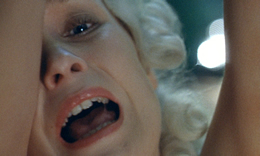 outrage, calculated to have audiences doubled over with both laughter and shock as it forges into increasingly dangerous waters. Fortunately Borowczyk manages to top even this with his berserk finale, which foreshadows a similar denouement in his equally fascinating and thematically similar Dr. Jekyll and His Women. The whole film has a wonderfully polished, exquisite look; it's arguably the director's most beautiful film and serves as a good introduction to his fondness for interlocking narratives and themes. It's also not bad as a couples film for open-minded audiences.
outrage, calculated to have audiences doubled over with both laughter and shock as it forges into increasingly dangerous waters. Fortunately Borowczyk manages to top even this with his berserk finale, which foreshadows a similar denouement in his equally fascinating and thematically similar Dr. Jekyll and His Women. The whole film has a wonderfully polished, exquisite look; it's arguably the director's most beautiful film and serves as a good introduction to his fondness for interlocking narratives and themes. It's also not bad as a couples film for open-minded audiences.
The video history of The Beast is long and complex, with various languages and alternate cuts floating around for over a decade. The most widely-seen English language version on VHS, Death's Ecstasy, deleted most of the horse footage and all images of the beast's prosthetic phallus. A French language print subtitled in English reinstated all of the graphic footage and appeared in U.K. cinemas in 2001, with a limited run in American art theaters shortly thereafter. This version was complete except for four minutes of tangential, dialogue-heavy footage which turned up only in a Dutch print, and it is this edit that has become the standard one today. Two different versions of The Beast appeared concurrently on DVD in the U.S. 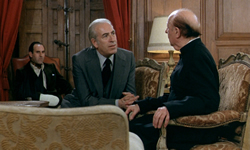 and U.K.; the latter from Nouveaux contained the aforementioned French version with burned-in subtitles. The first Cult Epics version (sporting the Argos logo at the beginning, as with Anchor Bay's Immoral Tales) instead had the English dubbed soundtrack. The merits of these audio options are tricky, as the film was post-synched in both languages. The English dub sounds rather canned, but Hummel was clearly speaking English throughout the film and this is the only version which matches her lip movements. However, the French track remains a more dry, elegant atmosphere and bolsters the film's effect as an intellectual comedy rather than a chunk of sleaze. No significant extras for either one, however.
and U.K.; the latter from Nouveaux contained the aforementioned French version with burned-in subtitles. The first Cult Epics version (sporting the Argos logo at the beginning, as with Anchor Bay's Immoral Tales) instead had the English dubbed soundtrack. The merits of these audio options are tricky, as the film was post-synched in both languages. The English dub sounds rather canned, but Hummel was clearly speaking English throughout the film and this is the only version which matches her lip movements. However, the French track remains a more dry, elegant atmosphere and bolsters the film's effect as an intellectual comedy rather than a chunk of sleaze. No significant extras for either one, however.
The Beast received a much more deserving special edition in a three-disc set from Cult Epics, with the first disc containing the general release version (dubbed a director's cut as Borowczyk edited out the superfluous footage himself). The anamorphic transfer looks nice and even cleaner than festival prints; more significantly, the disc also allows the viewer to toggle back and forth between the French and English tracks, with optional English subtitles. The disc also contains the uproarious theatrical trailer, which runs through most of the beast flashback while superimposing black boxes over the offending prosthetic. A stills gallery is also included.
Clocking in at a hearty two hours, disc two, "Beast Bis," sports a new video interview with Borowczyk in which he discusses the making of the film and its rocky exhibition history, a hefty 103-minute reel of silent behind-the-scenes footage featuring all of the actors and Borowczyk hard at work on the set, a Borowczyk bio, and more stills. The third disc offers the complete Dutch version of the film, with permanent English subtitles burned in a black band across the previous Dutch subs. It's an acceptable presentation of the only decent video master of this previously scarce edition of the film; thought the packaging designates it as widescreen, this version is almost completely open matte with the credits mildly letterboxed at 1.50:1. A gallery of lobby cards is also included. The beautiful package includes a stunning 52-page book, complete with eye-catching images from the film, along with text covering Borowczyk's career, symbolic influences, and thoughts on the film (as well as brief opinions from the two female leads).
The Arrow UK edition obviously ups the video quality by a huge degree and, rather surprisingly, features the longest 98-minute edition in pristine quality. It's a stunning presentation that outclasses the repertory prints that circulated in the early '00s, with the LPCM mono track representing the French version with a handful of English-shot asides between Lucy, her aunt, and the chauffeur (the best solution overall as it matches all of the actors' performances). It also features a completely different set of extras. Film critic Peter Bradshaw offers a brief (just under two minutes) video intro explaining how "incendiary" the film was, an act of "pure provocation." The hefty, 57-minute "The Making of The Beast" distills that making-of footage, copious stills, and new crew interviews to cover the unusual evolution of the film and its technical execution. The four-minute "Frenzy of Ecstasy: The Evolution of The Beast" utilized Borowczyk's sketches and notes to explore his conception of the titular creature, with a lengthy postscript about his proposed sequel involving a seal-like offspring. The four-minute 1975 Borowczyk short, "Venus on the Half Shell," mixes grotesquely erotic colored pencil drawings and live action footage for a meditation on the slippery nature of gender identity in nature. (Its connection to the main feature should be obvious after about ten seconds.) That crazy trailer pops up again to wrap up the disc.
For more Borowczyk, you can read reviews for DVD releases of his films including The Art of Love, Immoral Women, Love Rites, Behind Convent Walls, and the anthology film Private Collections, while The Story of Sin has also been issued on UK DVD. (Some of his cable TV projects and the complicated Emmanuelle V are a whole other ball game.) Sadly one of his finest works, the delirious erotic horror masterpiece Dr. Jekyll and His Women, has yet to receive a legitimate digital release anywhere in the world; also missing in action are Lulu and La Marge (The Streetwalker). Needless to say, there's more than enough room for another set or two for what now proudly stands as one of the most essential collections ever released for aficionados of daring European filmmaking.
Reviewed on September 12, 2014.



 period dramas to shocking, sexually explicit horror films. His esteemed reputation took a nosedive among critics when he unleashed his two most scandalous films in the mid-1970s, Immoral Tales and The Beast, but the ensuing years have led to many reappraisals finally reconciling his artistry and penchant for shock value. Various video labels have offered different releases over the years, but the most elaborate and satisfying by far is the astonishing collection assembled by Arrow Films in the U.K., available either as a limited edition set called Camera Obscura (which sold out very quickly) or as five individual editions with the same video contents, each on Blu-ray or DVD.
period dramas to shocking, sexually explicit horror films. His esteemed reputation took a nosedive among critics when he unleashed his two most scandalous films in the mid-1970s, Immoral Tales and The Beast, but the ensuing years have led to many reappraisals finally reconciling his artistry and penchant for shock value. Various video labels have offered different releases over the years, but the most elaborate and satisfying by far is the astonishing collection assembled by Arrow Films in the U.K., available either as a limited edition set called Camera Obscura (which sold out very quickly) or as five individual editions with the same video contents, each on Blu-ray or DVD.
 music to depict a race via automobile and balloon depicted in the style of 19th century print advertisements. The 9-minute "Renaissance" (1963) is very difficult to describe but basically involves lots of battered, discarded trash coalescing into an entire room with a doll, an owl, a painting, grapes, and so on; it's technically fascinating and the first real indication of the antiquity fascination that would become a defining trait in Borowczyk's later cinema. "Angels' Games" (1964) starts off with an abstract animation of a running train before morphing into 12 minutes of increasingly baroque, colorful visuals involving various winged creatures, viscera and wooden surfaces. "Joachim's Dictionary" (1965) is a slightly more traditional 9-minute piece of silliness with various words flashing on the screen between ink drawings of a man eating, spitting, changing outfits, and other easily definable (and often absurd) activities. "Rosalie" (1966) switches over to live action for a 15-minute study of a woman impregnated out of wedlock who tearfully deals with the aftermath of a life-changing decision. It's an eerie, poetic black-and-white miniature that leads nicely into some of the later works to come. Then "Gavotte" (1967) offers a crazy midget's eye view of life in a French imperial court, complete with humorous harpsichord music and some pretty hilarious gags that would never fly today. The same year's "Diptych" runs 8 minutes and features two "panels" about Leon Boyer, a 100-year-old bachelor tilling his garden and going out for a country drive, and a colorful study of flowers (and kittens!) set to Bizet music. What they have to do with each other is anyone's guess, but it looks gorgeous. "The Phonograph" (1969) runs a bit over 5 minutes and features stop-motion animation as the device of the title is shown operating in extreme detail, interspersed with shots of a shattered photograph and a rose. Then we jump ahead to 1978 for "The Greatest Love of All Time," a 9-minute fusion of painting footage, candid city shots, and Wagner music, with a slightly monstrous, sexy twist near the end. Finally, "Scherzo Infernal" (1984) uses narration, collage, and impressionistic animation to tell a story involving demons, fallen angels, and dark comedy within the flames of hell. Want even more? Among the special features you get a new one-minute introduction by Terry Gilliam, who reflects on the impression these shorts made on him decades ago, and the 28-minute featurette "Film Is Not a Sausage," with vintage interview footage of the late director, some of his regular collaborators (who will be discussed in more detail below), and various text excerpts and film clips covering this wildly productive aspect of his career. The 4-minute "Blow Ups" takes a closer look at Borowczyk's paper work in Poland and France, including some striking paintings and drawings with imagery later carried over to his film work (whose promotional artwork he sometimes designed as well). Finally you get a trio of lengthy commercials made between 1963-4: "Holy Smoke," "The Museum," and a pretty wild version of "Tom Thumb." Incidentally, this is the one of the two region-free titles out of the five. That leads us into...
music to depict a race via automobile and balloon depicted in the style of 19th century print advertisements. The 9-minute "Renaissance" (1963) is very difficult to describe but basically involves lots of battered, discarded trash coalescing into an entire room with a doll, an owl, a painting, grapes, and so on; it's technically fascinating and the first real indication of the antiquity fascination that would become a defining trait in Borowczyk's later cinema. "Angels' Games" (1964) starts off with an abstract animation of a running train before morphing into 12 minutes of increasingly baroque, colorful visuals involving various winged creatures, viscera and wooden surfaces. "Joachim's Dictionary" (1965) is a slightly more traditional 9-minute piece of silliness with various words flashing on the screen between ink drawings of a man eating, spitting, changing outfits, and other easily definable (and often absurd) activities. "Rosalie" (1966) switches over to live action for a 15-minute study of a woman impregnated out of wedlock who tearfully deals with the aftermath of a life-changing decision. It's an eerie, poetic black-and-white miniature that leads nicely into some of the later works to come. Then "Gavotte" (1967) offers a crazy midget's eye view of life in a French imperial court, complete with humorous harpsichord music and some pretty hilarious gags that would never fly today. The same year's "Diptych" runs 8 minutes and features two "panels" about Leon Boyer, a 100-year-old bachelor tilling his garden and going out for a country drive, and a colorful study of flowers (and kittens!) set to Bizet music. What they have to do with each other is anyone's guess, but it looks gorgeous. "The Phonograph" (1969) runs a bit over 5 minutes and features stop-motion animation as the device of the title is shown operating in extreme detail, interspersed with shots of a shattered photograph and a rose. Then we jump ahead to 1978 for "The Greatest Love of All Time," a 9-minute fusion of painting footage, candid city shots, and Wagner music, with a slightly monstrous, sexy twist near the end. Finally, "Scherzo Infernal" (1984) uses narration, collage, and impressionistic animation to tell a story involving demons, fallen angels, and dark comedy within the flames of hell. Want even more? Among the special features you get a new one-minute introduction by Terry Gilliam, who reflects on the impression these shorts made on him decades ago, and the 28-minute featurette "Film Is Not a Sausage," with vintage interview footage of the late director, some of his regular collaborators (who will be discussed in more detail below), and various text excerpts and film clips covering this wildly productive aspect of his career. The 4-minute "Blow Ups" takes a closer look at Borowczyk's paper work in Poland and France, including some striking paintings and drawings with imagery later carried over to his film work (whose promotional artwork he sometimes designed as well). Finally you get a trio of lengthy commercials made between 1963-4: "Holy Smoke," "The Museum," and a pretty wild version of "Tom Thumb." Incidentally, this is the one of the two region-free titles out of the five. That leads us into... After earning a name for himself with Kabal, Borowczyk embarked on his first live-action film with the peculiar and fascinating Goto, Island of Love in 1968. Though anyone acquainted with his later work might expect a combination of elegance and naughtiness, the film is quite a bit stranger than that, mixing political commentary with whimsical fantasy and poetic visuals into a truly unique and surprising experience.
After earning a name for himself with Kabal, Borowczyk embarked on his first live-action film with the peculiar and fascinating Goto, Island of Love in 1968. Though anyone acquainted with his later work might expect a combination of elegance and naughtiness, the film is quite a bit stranger than that, mixing political commentary with whimsical fantasy and poetic visuals into a truly unique and surprising experience.

 Face. The director's trademark oddball sense of humor is here as well, particularly in Gono's outrageous Machiavellian tactics which take several unusual twists and turns.
Face. The director's trademark oddball sense of humor is here as well, particularly in Gono's outrageous Machiavellian tactics which take several unusual twists and turns.
 Borowczyk’s second feature film, Blanche, earned some of the best reviews of his career and turned out to be a major success in the United Kingdom (despite lukewarm audience response in France). Apart from a bit of nudity in the opening moments it completely avoids the sensuality that would characterize his later work; instead we have a medieval melodrama mounted in the style of classical etchings and paintings with the camera taking a dispassionate, almost disturbing view of the increasingly violent events.
Borowczyk’s second feature film, Blanche, earned some of the best reviews of his career and turned out to be a major success in the United Kingdom (despite lukewarm audience response in France). Apart from a bit of nudity in the opening moments it completely avoids the sensuality that would characterize his later work; instead we have a medieval melodrama mounted in the style of classical etchings and paintings with the camera taking a dispassionate, almost disturbing view of the increasingly violent events.

 may also come as a bit of a surprise given that the set up feels more akin to bedroom farce, but that really just amplifies the impact of the conclusion even more. (The handheld final moments are especially wrenching.)
may also come as a bit of a surprise given that the set up feels more akin to bedroom farce, but that really just amplifies the impact of the conclusion even more. (The handheld final moments are especially wrenching.)  Of course, it was just a matter of time before Borowczyk dabbled in the anthology film, a craze Europe had been nurturing for quite a few years. This long lost art of the '60s and '70s allowed notable directors of all stripes and nationalities to experiment with any number of running times and story genres, with a wide range of actors at their disposal. Borowczyk found his greatest international success with this artsy, provocative variation on this formula, for which he somehow managed to rope in Pablo Picasso's fashion-savvy daughter, Paloma, to portray the real life, bloodthirsty Erzebeth Bathory. Needless to say, the results left quite an impression on unprepared moviegoers.
Of course, it was just a matter of time before Borowczyk dabbled in the anthology film, a craze Europe had been nurturing for quite a few years. This long lost art of the '60s and '70s allowed notable directors of all stripes and nationalities to experiment with any number of running times and story genres, with a wide range of actors at their disposal. Borowczyk found his greatest international success with this artsy, provocative variation on this formula, for which he somehow managed to rope in Pablo Picasso's fashion-savvy daughter, Paloma, to portray the real life, bloodthirsty Erzebeth Bathory. Needless to say, the results left quite an impression on unprepared moviegoers.

 Though Immoral Tales played U.S. theaters with an X rating, a small amount of footage was lost from most prints compared to the stronger European cut. One bit in particular of a girl "stuffing" herself with pearls is a bit more graphic on the first DVD edition released by Anchor Bay in the U.S., with that European cut remaining the standard today. Very briefly released on U.S. VHS during the format's infancy, Immoral Tales was previously only available to collectors for years through underground sources and PAL conversions of the British
Though Immoral Tales played U.S. theaters with an X rating, a small amount of footage was lost from most prints compared to the stronger European cut. One bit in particular of a girl "stuffing" herself with pearls is a bit more graphic on the first DVD edition released by Anchor Bay in the U.S., with that European cut remaining the standard today. Very briefly released on U.S. VHS during the format's infancy, Immoral Tales was previously only available to collectors for years through underground sources and PAL conversions of the British  video release. The DVD was a much-needed relief at the time after such a long wait, and the presentation was fine if not pristine. The disc featured burned-in English subtitles (alas), with the original French and English-dubbed tracks included. The mono sound was fine, again limited by its age and the quiet nature of the film. The lurid U.S. trailer, complete with critical blurbs, was also included and might still make it one to hang on to.
video release. The DVD was a much-needed relief at the time after such a long wait, and the presentation was fine if not pristine. The disc featured burned-in English subtitles (alas), with the original French and English-dubbed tracks included. The mono sound was fine, again limited by its age and the quiet nature of the film. The lurid U.S. trailer, complete with critical blurbs, was also included and might still make it one to hang on to.
 After earning a certain degree of mainstream credibility with Immoral Tales, Borowczyk immediately lost all of it shortly thereafter with La Bête (The Beast), a randy and explicit exploration of the underlying sexual motifs running through such fairy tales as "Beauty and the Beast" and "Little Red Riding Hood." The wordless 20-minute centerpiece of the film, in which noblewoman Sirpa Lane is pursued and ravished by a hairy and anatomically gifted beast, was that aforementioned component of Immoral Tales but seemed to
After earning a certain degree of mainstream credibility with Immoral Tales, Borowczyk immediately lost all of it shortly thereafter with La Bête (The Beast), a randy and explicit exploration of the underlying sexual motifs running through such fairy tales as "Beauty and the Beast" and "Little Red Riding Hood." The wordless 20-minute centerpiece of the film, in which noblewoman Sirpa Lane is pursued and ravished by a hairy and anatomically gifted beast, was that aforementioned component of Immoral Tales but seemed to  merit a separate film of its own. Borowczyk devised a crafty, Bunuelian narrative to surround this explosive little short, and soon he had quite a succès de scandale on his hands. Banned or heavily censored almost everywhere, The Beast was far more often spoken of than seen until it eventually resurfaced more or less intact on the English-speaking film circuit where its comic charms could be better appreciated.
merit a separate film of its own. Borowczyk devised a crafty, Bunuelian narrative to surround this explosive little short, and soon he had quite a succès de scandale on his hands. Banned or heavily censored almost everywhere, The Beast was far more often spoken of than seen until it eventually resurfaced more or less intact on the English-speaking film circuit where its comic charms could be better appreciated.
 outrage, calculated to have audiences doubled over with both laughter and shock as it forges into increasingly dangerous waters. Fortunately Borowczyk manages to top even this with his berserk finale, which foreshadows a similar denouement in his equally fascinating and thematically similar Dr. Jekyll and His Women. The whole film has a wonderfully polished, exquisite look; it's arguably the director's most beautiful film and serves as a good introduction to his fondness for interlocking narratives and themes. It's also not bad as a couples film for open-minded audiences.
outrage, calculated to have audiences doubled over with both laughter and shock as it forges into increasingly dangerous waters. Fortunately Borowczyk manages to top even this with his berserk finale, which foreshadows a similar denouement in his equally fascinating and thematically similar Dr. Jekyll and His Women. The whole film has a wonderfully polished, exquisite look; it's arguably the director's most beautiful film and serves as a good introduction to his fondness for interlocking narratives and themes. It's also not bad as a couples film for open-minded audiences.
 and U.K.; the latter from Nouveaux contained the aforementioned French version with burned-in subtitles. The first Cult Epics version (sporting the Argos logo at the beginning, as with Anchor Bay's Immoral Tales) instead had the English dubbed soundtrack. The merits of these audio options are tricky, as the film was post-synched in both languages. The English dub sounds rather canned, but Hummel was clearly speaking English throughout the film and this is the only version which matches her lip movements. However, the French track remains a more dry, elegant atmosphere and bolsters the film's effect as an intellectual comedy rather than a chunk of sleaze. No significant extras for either one, however.
and U.K.; the latter from Nouveaux contained the aforementioned French version with burned-in subtitles. The first Cult Epics version (sporting the Argos logo at the beginning, as with Anchor Bay's Immoral Tales) instead had the English dubbed soundtrack. The merits of these audio options are tricky, as the film was post-synched in both languages. The English dub sounds rather canned, but Hummel was clearly speaking English throughout the film and this is the only version which matches her lip movements. However, the French track remains a more dry, elegant atmosphere and bolsters the film's effect as an intellectual comedy rather than a chunk of sleaze. No significant extras for either one, however.
![]()